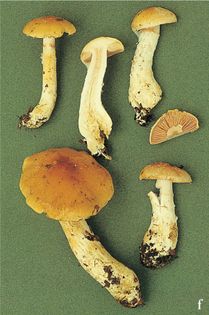Cortinarius (Phlegmacium) fraudulosus Britzelm. (illustrated 50% life size) Cap 2.5–6cm across, convex then expanded, slightly umbonate; pink-buff to tan-buff, becoming darker at the centre; margin initially silky white from the veil, slightly greasy, not viscid. Stem 25–80×10–15mm, swollen to 25mm at the base; pure white, discolouring pallid; base cottony. Flesh white, tinged pallid in stem; taste mild, smell faint but pleasant. Gills adnate; white at first, then ochre-clay. Spores 11–15.5×6.5–8¼, elliptical to almond-shaped, rough. Spore print rust. No reaction with NaOH. Habitat in beech woods; autumn. Very rare, vulnerable on Red Data List. Suspect avoid. Note this fungus fits very well the descriptions of C. fraudulosus, with its very large spores, but C. fraudulosus has been described as a European species from mountain spruce woods, not beech. Brandrud, Lindstrom, Marlund, Melot, and Muskos in their major work on Cortinarius mention that they think Cortinarius argutus is a complex group with different subspecies, each of which is associated with different tree hosts: it may be that one day this fungus will become a subspecies of C. argutus that is specific to beech, while their subspecies fraudulosus is associated with spruce.


